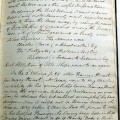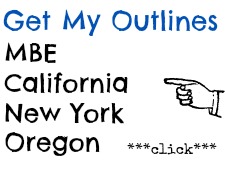 The basic steps in writing a good bar exam essay are:
The basic steps in writing a good bar exam essay are:
-
review and analyze the call of the question
-
skim the fact pattern with call in mind
-
read the call of question again and determine major topics
-
slowly read through the fact pattern and create your essay outline under each major topic heading
-
write response
This post will look at the first of these steps: Review and analyze the call of the question.
By carefully evaluating the call of the question, you will be able to glean a large percentage of what the examiners are looking for in a response.
Make sure that you do this first with every practice essay so that you engrain it as part of your essay answering routine. Then, you will not forget to do it on the exam.
Let’s practice this a few times.
Example No. 1
If Greasy Spoon brings an action in trespass against Donald for his use of the assigned parking spaces, is Greasy Spoon likely to prevail? Discuss.
Here, you know that someone is accused of trespass. Trespass is a tort. Recall the elements for both and be on the look out for them in the fact pattern.
But notice that the call also asks if Greasy Spoon is “likely to prevail.” This means that you should be on the look out for arguably unsatisfied elements as well as affirmative defenses. What are the possible defenses to trespass?
Example No. 2
What ethical violations, if any, has Jane committed? Discuss. Answer according to [your state] and ABA authorities
Not much to go on here, other than you know it is a professional responsibility question. Be sure to notice any areas where there are distinctions between how a violation is treated in different jurisdictions.
Example No. 3 — The Super-Vague Call
What causes of action might John’s mother reasonably assert against Big Biz, what defenses can Big Biz reasonably raise, and what is the likely outcome on each? Discuss.
Again, not a ton to go on, but it sounds like John got hurt by a corporation. Obviously, this is going to be a torts question. Probably negligence, strict liability, and/or products liability.
With companies, sometimes there are employee wrongs, so vicarious liability may come in to play.
There might even be a possibility of criminal liability.
Finally, the call asks for the defenses and likely outcome. Be alert for defenses and know that you will have to analyze it all and reach separate conclusions about each potential cause of action.
Example No. 4
How successful will Cynthia be if she moves to exclude her statement to Jill under the Fifth and/or Sixth Amendments to the United States Constitution? Discuss.
Can Cynthia be convicted of murder or of any lesser-included offense? Discuss.
Clearly, a criminal procedure/con law/crim law cross-over question.
The Fifth Amendment means Miranda. So, be on the look out for custody and interrogation, and waiver of rights. Be sure to pay attention when Cynthia makes her “statement.”
The Sixth Amendment means right to counsel. When does this right attach and did it attach in the facts given to you?
Murder and lesser-included offenses mean you will have to discuss quite a few crimes and be alert for possible defenses and mitigating circumstances. I hope you know all those elements.
Conclusion
As you can see, the call of the question is a very important part of each bar exam essay.
If you take a few seconds to analyze it critically, you will be much better able to discern and then analyze the relevant facts from the fact pattern that goes along with the call.
[Photo: http://www.flickr.com/photos/thunderchild5/433027225/]
P.S. -- Want a FREE copy of my Bar Exam Mind audiobook?
You can get a free copy of my audiobook when you sign up for a free trial at Audible. Get the details by clicking here.





